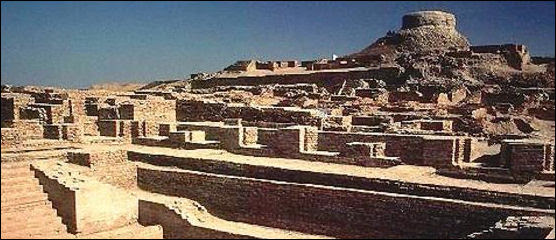GPSC Class- 1,2 Study Material - Indus Valley Civilization Part-2
Gujarati PDF File Is Available in The Bottom of the post
Mohenjo-Daro
 At least three major urban areas were located in the Indus River Valley:Mohenjo-Daro (also spelled Mohenjo-Daro), Harappa and Dholovira.
At least three major urban areas were located in the Indus River Valley:Mohenjo-Daro (also spelled Mohenjo-Daro), Harappa and Dholovira.
Mohenjo-Daro (350 miles from Karachi) was the center of an ancient Indus civilization, and perhaps its capital. The largest of several wealthy cities in the Indus Valley, Mohenjo-Daro covered about one square mile, only a small potion of which has been excavated. A man-made, plateau-like hill, known as the citadel, was on one side of the city. About 300 structures have been excavated there.
Mohenjo-Daro means "Mound of the Dead." The plateau-like citadel is believed to be have been the place where the rulers of the kingdom lived. The common people lived in the flatlands. At its height Mohenjo-Daro was home to maybe 80,000 people.
Founded perhaps 6000 years ago, Mohenjo-Daro flourished between 2500 and 2000 B.C. along the irrigated banks of the Indus River when the climate wasn't as harsh as it is today. Only Egypt can lay claim to a civilization that was as old and as large.
Exposing bricks found at Mohenjo-Daro was halted in the 1960s because the bricks began to crumble when exposed to the air. The problem is that the bricks have been soaked in ground water, leaving behind salt. Exposure to the sun and air draws out the moisture, leaving behind the salt, causing the bricks to crumble.
Harappa
Harappa (127 miles south of Lahore) was another large Indus city. It may have been a twin capital with Mohenjo-Daro. Named after a nearby town and 400 miles from its sister city, Mohenjo-Daro, it extended over an area of 1.25 square kilometers (400 acres) and was home to 20,000 or more people and probably controlled a New-York-size area covering about 50,000 square miles.
Harappa was located along the Rawa River, a tributary of the Indus, in a fertile flood plain. A reliable source of food helped the city take care of its own needs. Its location at the crossroads of important trade routes helped it prosper.
The Indus Valley civilization is sometimes called the Harappan civilization because the first evidence of the Indus culture was found there. Archeologists have found remains of a village dating back to 3300 B.C. at Harappa. Potsherds found there have symbols that are similar to the Indus script. By 2200 B.C. Harappa covered 370 acres and was home to about 80,000 people, making it roughly equivalent on side to Ur in Mesopotamia.
Harappa was discovered in 1921 and Mohenjo-daro was found a year later by Sir John Marshall. The sites have been continually excavated since then. British railroad workers scavenged large numbers of bricks from Harappa in the 1850s for ballast for their new tracks.

Mohenjodaro
Dholovira
Dholovira (30 miles from the Pakistan border) is another 5000-year-old city in the desolate Rann area of Kutch in far western India that once stood on an island in a marsh, periodically flooded by the Arabian Sea.
Dholavira was occupied between 2900 and 1500 B.C. with evidence of decline around 2100 B.C. Around 2000 B.C. the site was abandoned and the reinhabited around 1500 B.C. Tokens, seals and figurines that have been unearthed that are like those found at Mohenjo-Daro and Harappa.
Scholars believe that Dholavira may have supplied salt to the Indus area and was once connected to the Arabian Sea by a channel or canal though no evidence of such a waterway has been found. Other large Indus settlements include Lurewala in the central Indus valley, Ganweriawala in the Cholistan desert and Kalibangan and Lothal in India. Some have suggested that this were independent city states. Other have argued they were provincial capitals under Harappa and Mohenjo-daro.

Mohenjodaro
Indus Language and the World's Oldest Writing?
Some scholars believe the Indus people spoke a language that belongs the Dravidian family, which includes Tamil and about 25 other languages, many of them spoken in southern India.
The language of Mohenjo-Daro is among the written languages that have not been deciphered. Other include the Minoan language of Crete; the pre-Roman writing from the Iberian tribes of Spain; Sinaitic, believed to be a precursor of Hebrew; the Futhark runes from Scandinavia; Elamite from Mesopotamia; the earliest Egyptian hieroglyphics; and Archaic Sumerian, the earliest written language in the world.
Important For You
Important For You
| Gujarati Sahitya | Check Gujarati Sahitya Book By GCERT |
| Computer | Computer PDF By Ice Rajkot |
| Bandharan | Download bandharan Book By Ice Rajkot |
| Bhugol | Gujarat Ni Bhugol By Angel Academy |
A 5,500 year-year-old inscription found on pottery in Pakistan in 1999 may be the world's oldest writing. A piece of pottery found at Harappa, dating between 3300 and 3000 B.C., contains branch-like lines that are similar to a trident-shaped symbol that appeared centuries later.
The Indus people had a written language. Thousands of examples have been unearthed. Despite the best efforts by scholars, it is still undeciphered. This is one of the main reasons why so much about the Indus culture remains a mystery.
Writing found on stone seals may have served as a form of personal identification. Seals sometimes had writing accompanied by figures of people, animals or mythical beats. Writing has also been found on button seals and inscribed shards.
GPSC Class 1,2 Study Material - Bhakti Andolan Part-1
GPSC Class- 1,2 Study Material - Indus Valley Civilization Part-2
4/
5
Oleh
techgujgk

